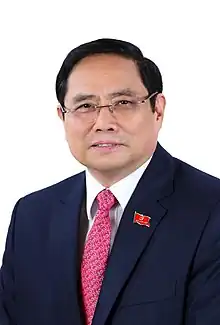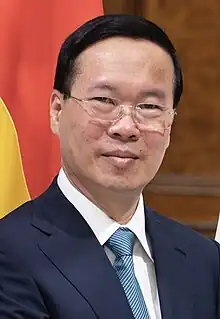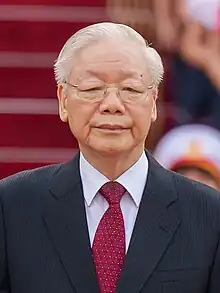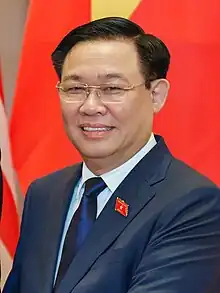The four pillars (tứ trụ) is a Vietnamese informal term for the four most important bureaucrats in the government. In modern usage, the four pillars refer to the Prime Minister, President, General Secretary of the Communist Party, and Chairman of the National Assembly.[1][2] Together, they are officially called the "Key Leaders of the Party and State" (Lãnh đạo chủ chốt của Đảng, Nhà nước) and can be considered as the de facto heads of state.[3] Similar to China, there does not exist an official order of precedence for political leaders and rather they are inferred in a de facto fashion. This division of power is formed prevent dictatorial rule and preserve consensus-based leadership, which is officially called by the Vietnamese Communist Party as "democratic centralism".[4]
See also
- Paramount leader – China
References
- ↑ Hai Hong Nguyen (2020-01-09). "Vietnam prepares for 'four pillars' elections". Asia Times. Retrieved 2020-12-08.
- ↑ "Ai sẽ vào 'tứ trụ' ở Đại hội XIII và bước tiếp của 'Đốt lò'". BBC Tiếng Việt. 2020-01-22. Retrieved 2020-12-08.
- ↑ "Kết luận số 35-KL/TW date 05/5/2022 của Bộ Chính trị về danh mục chức danh, chức vụ lãnh đạo và tương đương của hệ thống chính trị từ Trung ương đến cơ sở | Hệ thống văn bản". tulieuvankien.dangcongsan.vn. Retrieved 2023-11-27.
- ↑ David Hutt (2020-09-14). "Three-Horse Race for Vietnam's Next Communist Party Chief". The Dilplomat. Retrieved 2020-12-08.
In the early 1990s, a "four pillar" system was accepted so that the top four political offices – Party General Secretary, State President, Prime Minister and National Assembly chairperson – were occupied by different people. The idea was to prevent dictatorial rule and preserve consensus-based leadership – what the Party calls "democratic centralism."



